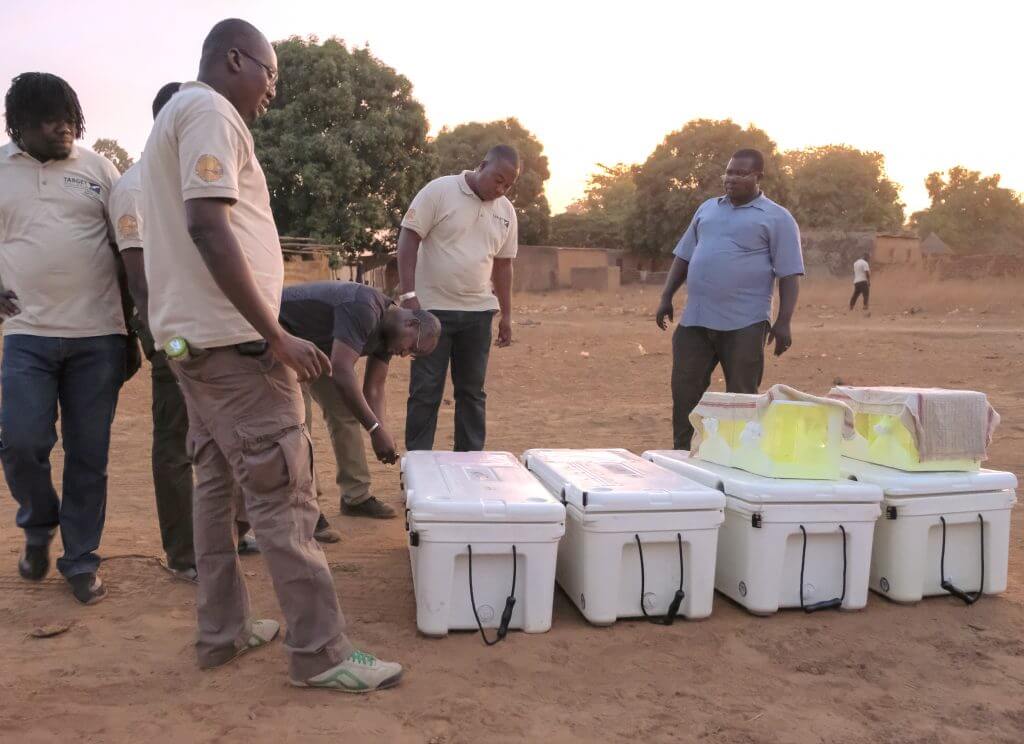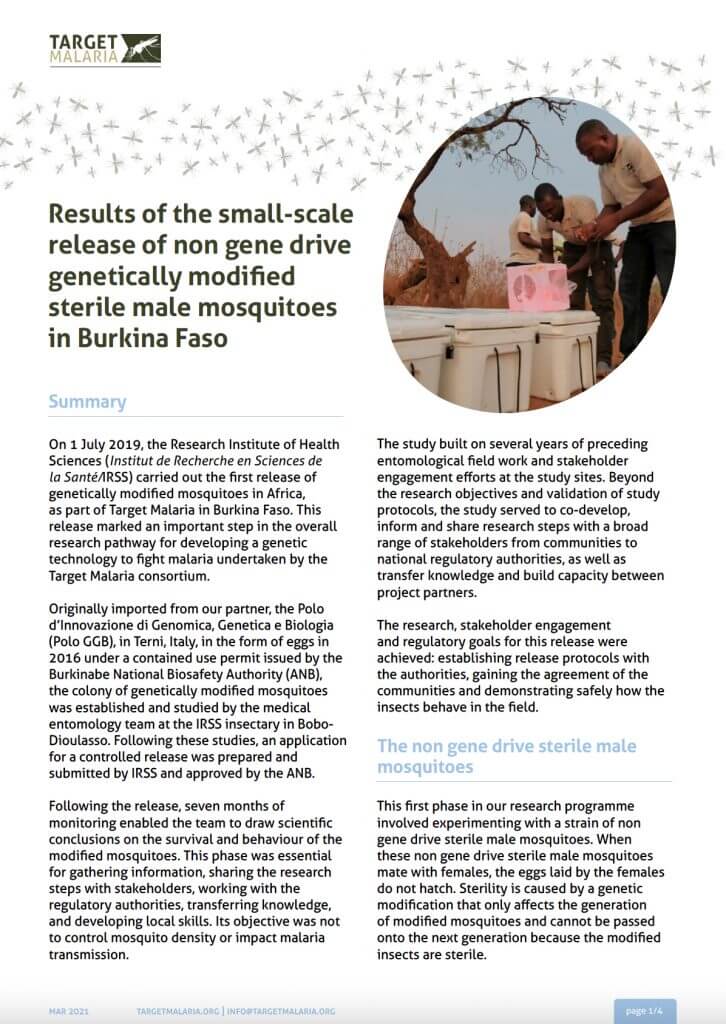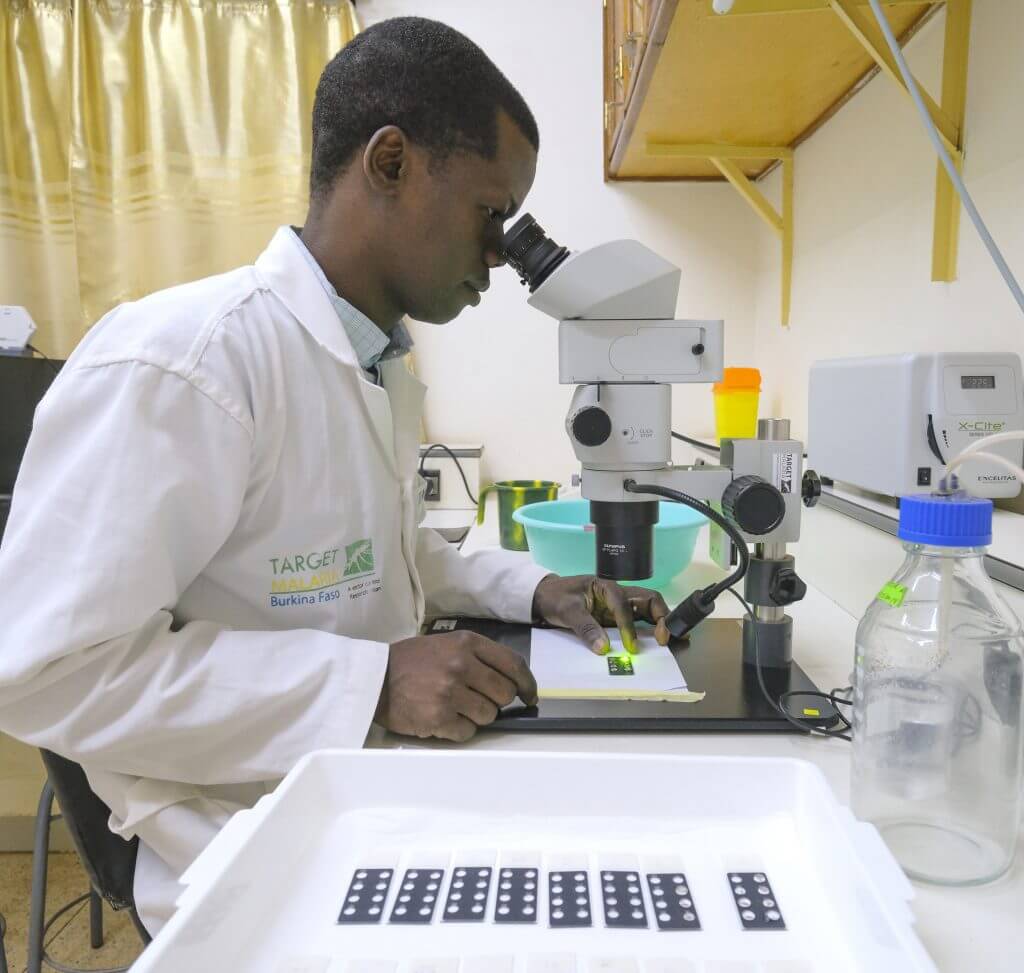Results from months of monitoring following the first release of non gene drive genetically modified mosquitoes in Africa

On July 1, 2019, Target Malaria in collaboration with the National Institute of Health Sciences (the Institut de Recherche en Sciences de la Santé-IRSS) proceeded with the small-scale release of non gene drive genetically modified sterile male mosquitoes in the village of Bana, in Burkina Faso.

This release was the first ever done in Africa and marked an important milestone for Target Malaria and for vector control research. It enabled us to work closely with the stakeholders and the regulatory authorities; it provided a lot of information regarding the behaviour of modified mosquitoes in the field. It was also a capacity-building opportunity for the whole team on how to import, rear, transport and release and monitor non gene drive genetically modified mosquitoes.
The National Biosafety Agency (Agence Nationale de Biosécurité-ANB) – the in-country competent authority for biotechnology and biosafety regulations – authorized the project to first import the eggs of genetically modified mosquitoes from the partner institution Polo d’Innovazione di Genomica, Genetica e Biologia-PoloGGB in Italy and then perform the release of these mosquitoes in the wild. Following years of engagement and continuous dialogue between the project and members of the village, the community of Bana provided their agreement for the release to take place on their land.
The Target Malaria team at IRSS released approximately 6,400 non gene drive genetically modified sterile male mosquitoes of the Anopheles gambiae species and approximately 8,500 non-modified mosquitoes in the framework of a comparative study. We then used the Mark, Release, Recapture technique to track them. It is important to note that this release will not have any impact on malaria vector mosquito density and malaria transmission in Bana nor in Burkina Faso. Because the released mosquitoes are male and sterile, they do not bite and they will die without having offspring. The objective of the release was not yet to test a potential vector control tool. The sterile male mosquitoes are genetically modified but do not carry a gene drive element that biases its inheritance.
After seven months of monitoring following the release, our team was able to collect essential information:
- Non gene drive sterile male mosquitoes were recaptured in swarms, showing that they can take part in swarming activities (important for reproduction) in a similar manner to wild mosquitoes. Non-modified male mosquitoes were also recaptured as well as wild-type male mosquitoes.
- Non gene drive sterile male mosquitoes were recaptured inside homes, showing that, like wild males, they sometimes prefer to shelter inside houses.
- Non gene drive sterile male mosquitoes did not disperse beyond the release village boundaries, and were comparatively less mobile than wild type released mosquitoes.
- The survival of the released insects was also estimated. Sterile male mosquitoes did not survive as long as their released non-modified counterparts.
- Following the 20-day daily recapture period of the MRR, regular monthly monitoring assisted by molecular analyses continued for a total of 7 months and, as expected, no genetically modified mosquitoes were detected during this period.
- The release, MRR study, and monitoring activities, all proceeded as planned. All steps leading to the release, including transport and the release itself were conducted in presence of observers of the ANB who also checked all protocols. Reporting obligations have now been finalised.

The intensive MRR study lasted for 20 days and was followed by seven months of monitoring to verify the disappearance of the transgene from the environment. The data has been reported to the ANB. The stakeholder engagement team has spent the last months informing affected communities and other stakeholders of the results and lessons learned from the study.
For more information on the release and its results: Results of the small-scale release of non gene drive genetically modified sterile male mosquitoes in Burkina Faso.
…
Target Malaria Burkina Faso is proud to have successfully concluded the first release of non gene drive genetically modified mosquitoes in Africa and the monitoring of the release over 2019 and 2020. This is a historic moment for Burkina Faso and a notable milestone for the project. The project still has a long way to go but these results reinforce our resolve and commitment.
We are now working on the request for permission to import another non gene drive genetically modified mosquito that we call the non gene drive male bias. This mosquito does not carry a gene drive element that biases its inheritance either. It is modified so that its offspring are predominantly male. It will not have any impact on malaria. We will not be releasing more genetically modified mosquitoes in 2021.

In the long term, our goal is to develop and share a genetically modified mosquito with the gene drive technology that will allow the modification to persist among the population of malaria vector mosquitoes for generations. It is only this type of mosquito that would be able to control malaria.
While the results so far are promising, it will take years of research before we have a gene drive mosquito that can be used in the fight against malaria. We have no plans to release a gene drive mosquito in Burkina Faso in the near future. Target Malaria uses a cautious and step-wise approach to co-develop and share a long-term, cost-effective and sustainable technology for fighting malaria. We are proud that Burkina Faso is at the forefront of this innovative cutting-edge research.
